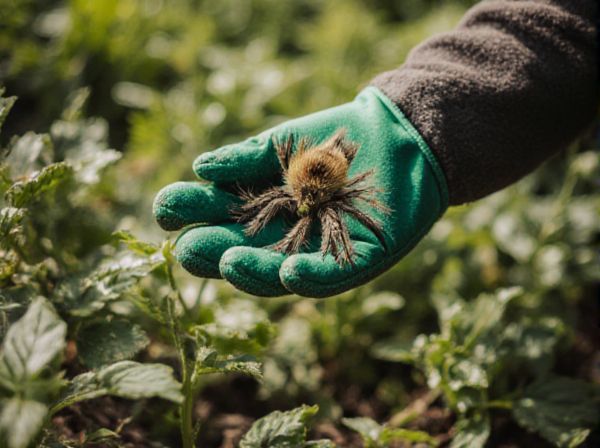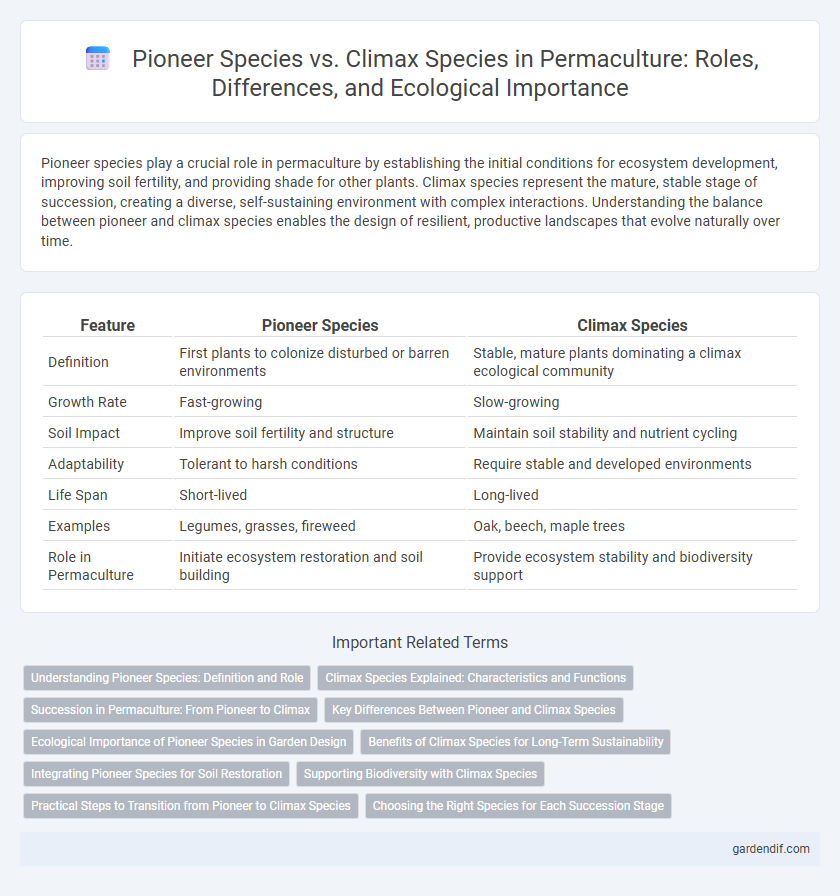
Pioneer Species vs Climax Species Illustration
Pioneer species play a crucial role in permaculture by establishing the initial conditions for ecosystem development, improving soil fertility, and providing shade for other plants. Climax species represent the mature, stable stage of succession, creating a diverse, self-sustaining environment with complex interactions. Understanding the balance between pioneer and climax species enables the design of resilient, productive landscapes that evolve naturally over time.
Table of Comparison
| Feature | Pioneer Species | Climax Species |
|---|---|---|
| Definition | First plants to colonize disturbed or barren environments | Stable, mature plants dominating a climax ecological community |
| Growth Rate | Fast-growing | Slow-growing |
| Soil Impact | Improve soil fertility and structure | Maintain soil stability and nutrient cycling |
| Adaptability | Tolerant to harsh conditions | Require stable and developed environments |
| Life Span | Short-lived | Long-lived |
| Examples | Legumes, grasses, fireweed | Oak, beech, maple trees |
| Role in Permaculture | Initiate ecosystem restoration and soil building | Provide ecosystem stability and biodiversity support |
Understanding Pioneer Species: Definition and Role
Pioneer species are the first plants to colonize disturbed or barren land, initiating ecological succession by improving soil quality and creating microenvironments for other species. These hardy species, such as legumes and fast-growing grasses, fix nitrogen, stabilize soil, and increase organic matter, facilitating the establishment of climax species. Their role is crucial in permaculture systems for jumpstarting ecosystem development and enhancing biodiversity.
Climax Species Explained: Characteristics and Functions
Climax species are the final, stable plants in a succession process, characterized by slow growth, longevity, and high resource efficiency. These species create a balanced ecosystem by supporting biodiversity, enhancing soil quality, and stabilizing microclimates. Their deep root systems and dense canopies play a crucial role in nutrient cycling and habitat formation within permaculture designs.
Succession in Permaculture: From Pioneer to Climax
Pioneer species play a crucial role in permaculture succession by initiating soil improvement and creating conditions suitable for more complex plants. Climax species represent the stable, mature community that emerges after successive stages, offering long-term ecological balance and resource efficiency. Understanding the transition from pioneer to climax species enables effective design of sustainable ecosystems that mimic natural succession.
Key Differences Between Pioneer and Climax Species
Pioneer species rapidly colonize disturbed or barren environments, exhibiting fast growth, high reproductive rates, and tolerance to harsh conditions. Climax species dominate stable, mature ecosystems, characterized by slower growth, longer lifespans, and specialized adaptations for resource competition. The key differences lie in their ecological roles, with pioneer species initiating succession and climax species maintaining ecosystem equilibrium.
Ecological Importance of Pioneer Species in Garden Design
Pioneer species play a crucial ecological role in garden design by initiating soil stabilization and nutrient cycling in disturbed or barren areas, creating conditions conducive for subsequent plant succession. These species, often hardy and fast-growing, improve soil fertility through nitrogen fixation and organic matter accumulation, paving the way for climax species that establish long-term biodiversity and ecosystem stability. Incorporating pioneer species in permaculture systems accelerates habitat restoration and enhances resilience against environmental stressors.
Benefits of Climax Species for Long-Term Sustainability
Climax species enhance long-term sustainability by stabilizing ecosystems through complex root systems that prevent erosion and improve soil health. Their mature biomass supports diverse wildlife habitats and fosters nutrient cycling, creating resilient environments resistant to pests and climate fluctuations. These species promote carbon sequestration, contributing to climate regulation and sustained ecosystem productivity.
Integrating Pioneer Species for Soil Restoration
Pioneer species play a crucial role in soil restoration by establishing quickly on degraded land, improving soil structure, and increasing organic matter through leaf litter and root activity. These species, such as nitrogen-fixing legumes and hardy grasses, create favorable conditions for climax species by enhancing nutrient availability and stabilizing the ecosystem. Integrating pioneer species in permaculture designs accelerates succession, promoting long-term sustainability and diverse plant communities.
Supporting Biodiversity with Climax Species
Climax species play a vital role in supporting biodiversity by creating stable, mature ecosystems that provide diverse habitats and resources for various flora and fauna. Unlike pioneer species that quickly colonize disturbed areas, climax species establish long-term ecological balance, promoting soil health, nutrient cycling, and intricate food webs. Integrating climax species in permaculture designs enhances ecosystem resilience and sustains biodiversity over time.
Practical Steps to Transition from Pioneer to Climax Species
Implementing practical steps to transition from pioneer to climax species involves initially planting fast-growing, nitrogen-fixing pioneer species like alder or clover to improve soil fertility and structure. Gradually introduce slower-growing climax species such as oak or beech by creating shaded conditions and reducing disturbance to mimic natural succession. Monitoring soil health and adjusting planting density ensures a stable and sustainable ecosystem reflecting the desired climax community.
Choosing the Right Species for Each Succession Stage
Pioneer species, such as nitrogen-fixing legumes and fast-growing grasses, are essential for initiating soil improvement and stabilizing degraded land during early succession stages. Climax species like mature oaks and maples are suited for late succession, creating stable, biodiverse ecosystems with complex canopy layers. Selecting the right species for each succession stage accelerates ecosystem development, enhances soil fertility, and promotes sustainable permaculture design.
Pioneer Species vs Climax Species Infographic

 gardendif.com
gardendif.com